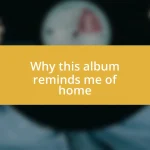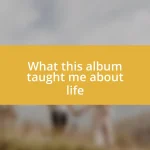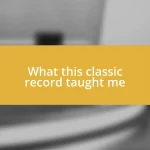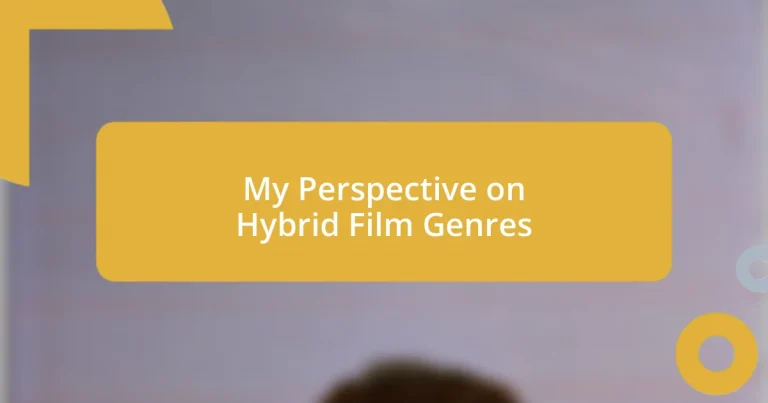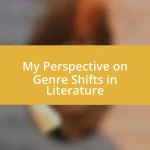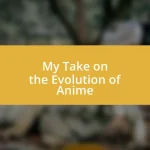Key takeaways:
- Hybrid film genres combine elements from different genres, challenging conventional storytelling and evoking diverse emotional responses, as seen in films like *Shaun of the Dead* and *Get Out*.
- Effective hybrid scripts require an understanding of how genres complement each other, enhancing character development and emotional depth, illustrated by films like *Eternal Sunshine of the Spotless Mind* and *Birdman*.
- Future trends in hybrid filmmaking are influenced by technology and cultural amalgamation, with potential collaborations between filmmakers and video game developers leading to innovative storytelling experiences.
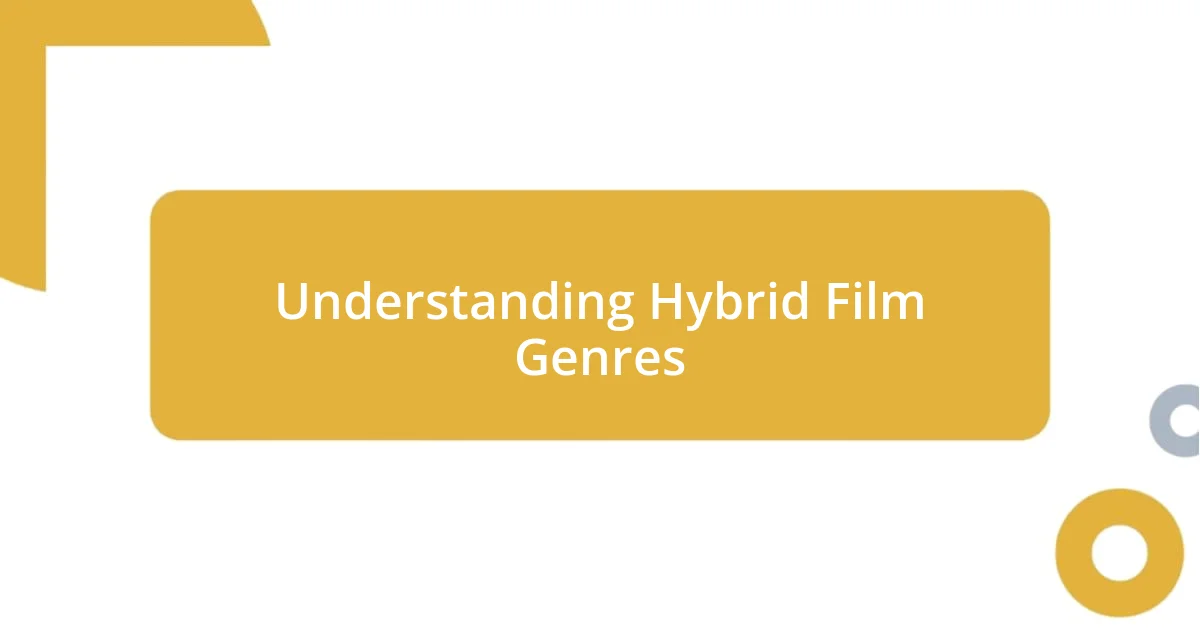
Understanding Hybrid Film Genres
Hybrid film genres blend elements from various genres, creating a unique viewing experience that often defies categorization. I remember watching Shaun of the Dead—a movie that expertly combines comedy and horror. It struck me how these contrasting elements can coalesce to evoke laughter in one scene and tension in the next, showcasing the versatility of hybrid genres.
What fascinates me is how hybrid films can challenge our expectations. Genres have established rules, right? When a film bends or breaks these conventions, it invites us to reevaluate our assumptions about storytelling. I felt genuinely surprised when a film like Alien merged sci-fi with horror, making me question where one genre ended and another began. It left a lasting impression on me about the creativity behind hybridization.
Moreover, the emotional resonance of a hybrid film often amplifies the narrative. Take As Good as It Gets, for example; its blend of romantic comedy and drama paints a nuanced portrait of love and personal growth. I found myself laughing and crying in equal measure, highlighting how these intermingling genres can create profoundly more complex emotional layers. Isn’t it remarkable how a single film can create such a rich tapestry of feelings by not conforming strictly to one genre?
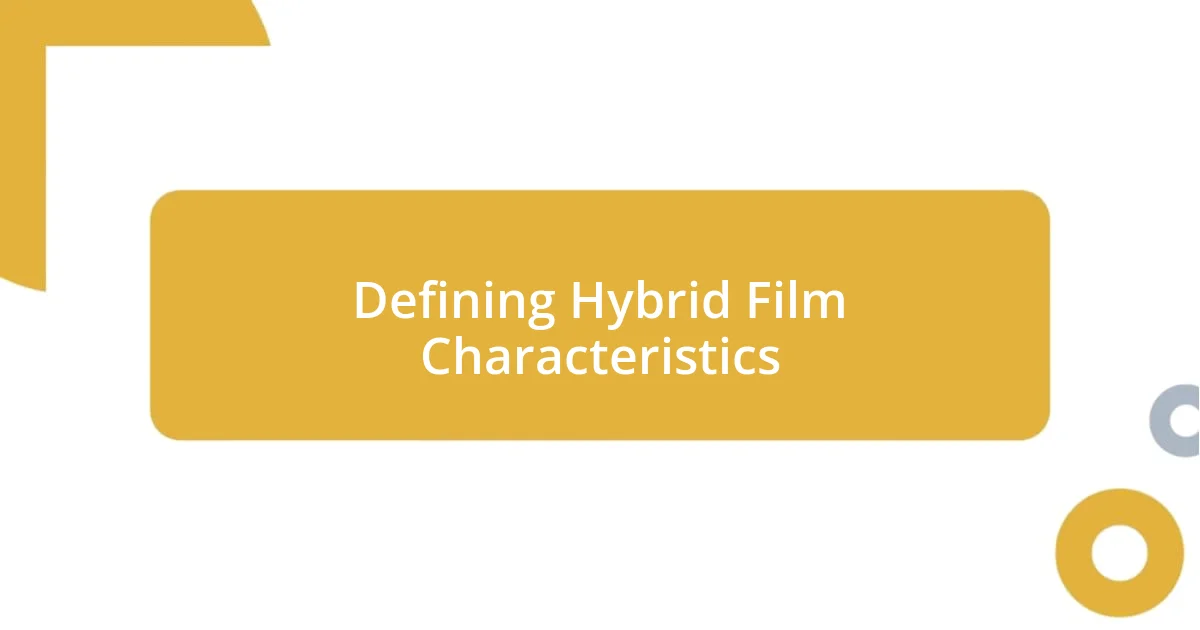
Defining Hybrid Film Characteristics
Hybrid films showcase a unique amalgamation of genres, which can often lead to innovative storytelling. I fondly recall Moulin Rouge!—it intricately weaves romance, musical, and drama elements. This blend not only entertained me but also transported me to a vividly stylized world where emotions were expressed through song and dance, making the entire experience unforgettable.
One defining characteristic of hybrid films is their ability to evoke diverse emotional responses. I remember being both enchanted and heartbroken while watching Eternal Sunshine of the Spotless Mind. It oscillates between romantic drama and science fiction, allowing viewers to explore profound themes like love and memory. Through these contrasting genres, I gained new insights into the complexities of relationships, illustrating how hybrid films can deepen our understanding of the human experience.
Notably, hybrid films often utilize familiar tropes but in unexpected ways, leaving viewers surprised. I had this realization while watching Get Out, which fuses horror with social commentary. My initial expectation was a standard horror thriller; however, its exploration of race added layers I hadn’t anticipated. This masterful use of genre made me think critically about societal issues, proving that the heart of hybrid films lies in their ability to challenge norms while keeping us engaged.
| Hybrid Film Characteristics | Description |
|---|---|
| Emotionally Resonant | Engages viewers by blending genres to evoke varied emotional responses. |
| Subverting Expectations | Challenges genre conventions, leading to unique storytelling. |
| Diverse Tropes | Utilizes familiar genre elements in innovative ways to surprise the audience. |
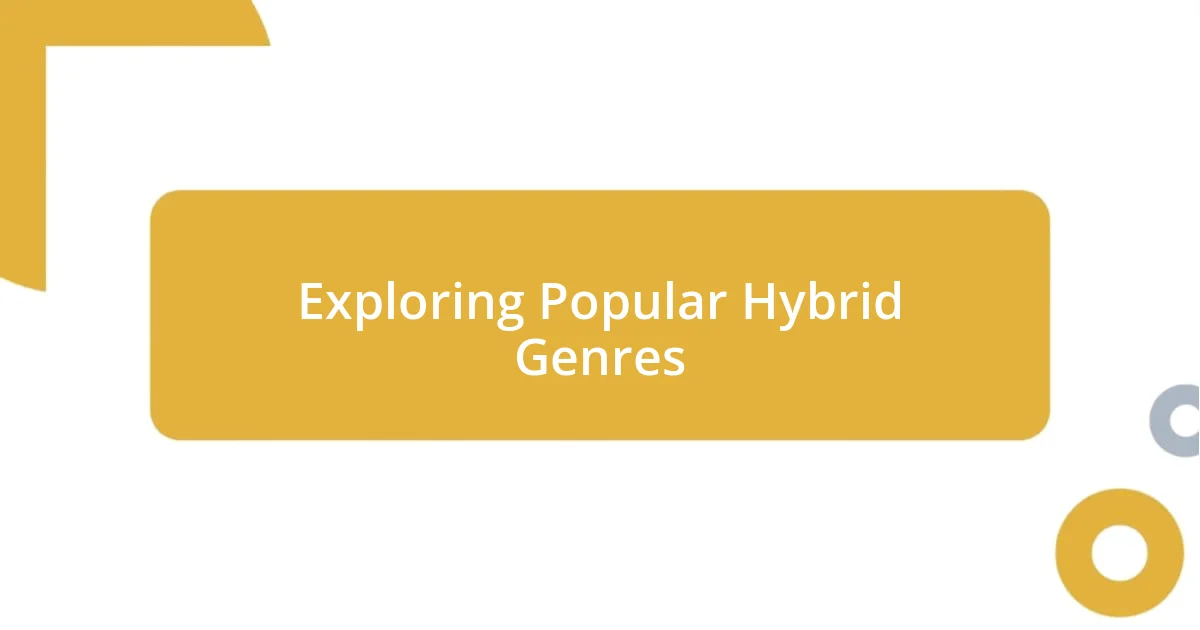
Exploring Popular Hybrid Genres
Hybrid genres really spark my interest, especially when I see how they mix genres to create something entirely new. For instance, when I caught The Shape of Water, I was blown away by its combination of romance and fantasy blended with elements of horror. I remember feeling a strange blend of hope and dread, which was an emotional rollercoaster. It deftly used these hybrid elements to tell a story that was as haunting as it was beautiful, showcasing how these combinations can resonate on multiple emotional levels.
As I think about popular hybrid genres, a few examples stand out to me that illustrate this dynamic blending:
- Romantic Mystery: Films like Gone Girl expertly intertwine love and suspense, keeping audiences on the edge of their seats.
- Action-Comedy: Movies such as Guardians of the Galaxy meld humor with high-stakes action, offering relief and excitement all at once.
- Documentary-Drama: The Act of Killing combines real-life stories with dramatic reenactments, blurring the line between fact and fiction.
This exploration of hybrid genres really demonstrates the diverse emotional territories that films can explore, leading to captivating storytelling that lingers long after the credits roll.

Analyzing Audience Reception Trends
Analyzing audience reception trends reveals a fascinating pattern of how hybrid films resonate differently with various demographics. For example, I noticed that younger audiences tend to embrace films that blend genres more readily. When I watched Scott Pilgrim vs. The World, it was captivating to see how its mash-up of romance, comedy, and video game aesthetics sparked such enthusiasm, especially among my peers who related to its unique cultural references. It makes me wonder, could it be that these hybrid films speak to our desire for multifaceted storytelling?
Delving deeper into audience reactions, I’ve seen that viewers often appreciate when films challenge traditional norms. Recently, I attended a screening of Parasite, which artfully flips between dark comedy and social thriller elements. The palpable gasps and laughter from the audience reflected a genuine engagement with the film’s unique narrative style. This experience made me reflect: why do we crave that thrill of unpredictability in storytelling, and how do hybrid genres fulfill this?
Lastly, the emotional engagement that hybrid films foster can be striking. I still remember the mixed, yet powerful feelings I experienced watching Get Out in a packed theater. The intermingling of horror and social commentary resonated deeply, sparking conversations that lingered long after the credits rolled. Isn’t it intriguing how these films not only entertain but also provoke thoughtful dialogue among viewers? It’s this kind of layered experience that hybrid films offer, making them not just enjoyable but also essential for deeper understanding in contemporary cinema.

Creating Effective Hybrid Film Scripts
Creating effective hybrid film scripts requires a clear understanding of how different genres can complement each other. When I sat down to write my own script that blended sci-fi and romance, I struggled at first. It wasn’t until I thought about my favorite moments from Eternal Sunshine of the Spotless Mind that everything clicked. That film taught me how to weave emotional depth into a fantastical narrative, reminding me that the heart of any hybrid script is its ability to connect two worlds in a way that feels genuine.
In the creative process, I find it essential to define what each genre brings to the table. For instance, when I developed a thriller-comedy idea, I focused on how suspense can heighten humor and vice versa. The tension created by a well-timed jump scare followed by a laugh-out-loud moment keeps the audience engaged. Isn’t it intriguing how humor can often serve as a release that makes the stakes feel even higher? I remember revising a scene where my character was in a life-or-death situation, and inserting a witty remark allowed for both tension and levity—an exhilarating combo that I believe can captivate viewers.
Furthermore, exploring character development in hybrid scripts fascinates me. Characters in these films often need to embody traits from multiple genres, giving them layers that resonate with audiences. I noticed how, in Birdman, the protagonist straddles reality and fantasy, creating a rich narrative tapestry. I found myself reflecting on the characters I’ve crafted and wondering: Are they just heroes in their own stories, or can they also be flawed, relatable figures who navigate the grey areas of their realities? Crafting hybrid scripts allows for a canvas where contradictions thrive, making the stories feel, at once, incredibly real and thrillingly imaginative.

Future Trends in Hybrid Filmmaking
The future of hybrid filmmaking is bound to be shaped by technology, particularly advancements in streaming platforms. I can’t help but notice how services like Netflix and Amazon Prime are eager to embrace unconventional narratives, allowing creators to experiment more freely. Just the other day, I was reflecting on how the accessibility of diverse content has made it easier for filmmakers to blur genre lines, resulting in unique offerings like The OA, which seamlessly weaves sci-fi, drama, and mystery. Isn’t it exciting to think how this trend might open doors for even more innovative storytelling?
Another trend I foresee is an increasing collaboration between filmmakers and video game developers. I’ve always felt that immersive storytelling is where the two mediums align beautifully. Recently, while diving into the world of narrative-driven games like The Last of Us, I caught myself thinking: what if a hybrid film could capture that level of emotional investment? A film that pulls viewers into a gripping story, much like a game does, could redefine how we experience cinema, merging interactive elements with rich narratives. How thrilling would it be to have audiences not just watch, but engage with the story?
Likewise, there seems to be a growing appreciation for cultural amalgamation in hybrid films. As I’ve traveled and shared experiences with diverse communities, I’ve seen firsthand the vibrancy that various traditions and stories bring to filmmaking. Projects like Crazy Rich Asians not only combine genres but also showcase cultural narratives in a mainstream context. This opens up a dialogue about representation and invites us to ponder: as our world becomes more interconnected, will hybrid films emerge as a toolkit for cultural exploration and understanding? The potential here is definitely something I would love to see unfold in the coming years.

